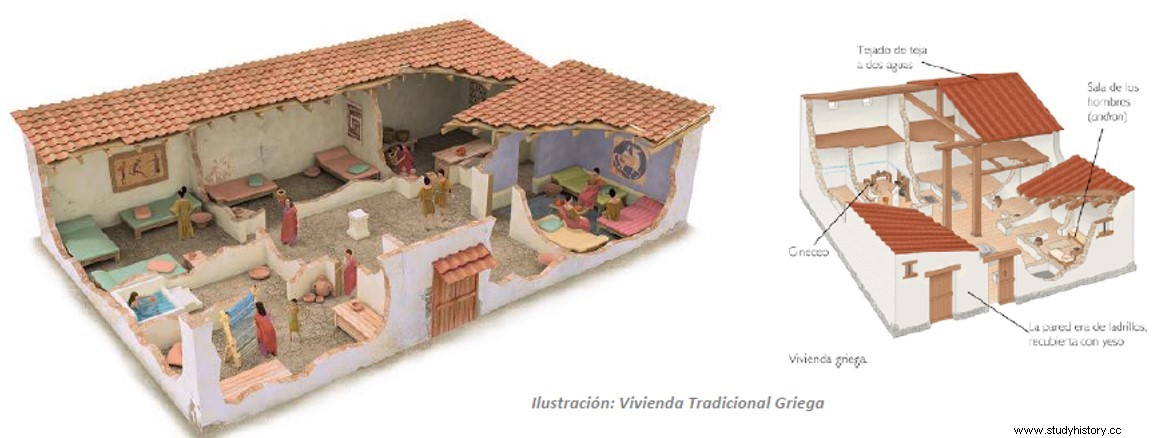Nowadays, one of the techniques used in bioclimatic architecture is passive solar technology, which is nothing more than the direct use of solar energy without transforming it into another type of energy. Well, even if it didn't have such a chic name , in Ancient Greece they already took it into account when building their buildings. As the Greek historian Xenophon tells us, the wise Socrates he already anticipated how the houses should be built:
When someone wants to build the right house, he must make it as pleasant to live in and as useful as possible. And isn't it nicer to have a cool house in the summer and a warm house in the winter? In houses facing south, the winter sun enters the rooms through the porches, but in the summer it passes over our heads, giving us shade. It is necessary that in the houses that face south there is a second floor so that the sun is not hidden during the winter, and that those that face north are lower, so that the north winds cannot penetrate.
The successful application of Socratic measures in bioclimatic issues in some homes in Athens extended their use to rural areas, where it was much easier to choose the orientation. In the 5th century BC C., on the ancient city of Olinto , founded by the Chalcideans, was built what we could consider the first solar city in history.


Archaeological discoveries have allowed us to establish a structure for the city:seven north-south streets crossed perpendicularly every 35 meters by east-west streets. All have a width of 5 meters, except the central streets of both directions that measured 7 meters. In the grids —today blocks— configured by the intersections of streets the houses were located, all facing south. This planning allowed for a more convenient layout of the houses in order to obtain maximum solar benefit.
Later, Aristotle he would also defend similar basic principles of architecture by stating that “ sheltering from the cold north and taking advantage of the heat of the sun is a modern and civilized way ”. And the playwright Aeschylus he had already used architecture to distinguish the civilized Greeks from the barbarians:
[…] Although they had eyes to see, they saw in vain; they had ears, but they did not understand. Like the forms in dreams, throughout their time, without purpose they threw all things into confusion. They had no knowledge of houses, turned to face the sun, and dwelled underground like swarming ants in sunless caves.
And as almost always happened, the Romans took the idea and gave it a spin to improve it. Greek building techniques were suitable for a typical Mediterranean climate, but Vitruvian , the Roman architect and engineer of the 1st century BC, in Book VI of his treatise De architectura , went further…
If we want our house designs to be correct, we must begin by taking careful note of the countries and climates in which they are to be built. […] It seems convenient that the buildings are vaulted in the northern countries, closed rather than open and always oriented towards the warmer parts. On the contrary, in southern countries, punished by a scorching sun, the buildings must be open and oriented towards the northwest. Thus, through art, the inconveniences caused by nature itself must be alleviated. In the same way, constructions in other regions will be adapted, always in relation to their diverse climates and their latitude. All this we must observe and consider from the same nature...

Likewise, Vitruvio talks about the treatment and capture of light, the chosen materials and their arrangement, the orientation of the rooms depending on their use...
The bedrooms and libraries should be oriented towards the east, since the use of these rooms requires the light of dawn and, in addition, it will prevent the books from rotting on the shelves. If they are oriented towards the south or towards the west, the books end up spoiling as a result of moths and humidity, since the humid slow motion, which blows from said cardinal points, generates and feeds the moths and when their moist air penetrates it molds and spoils all the volumes. […] Similarly, the art galleries, the embroidery rooms, the painting studios, will be oriented towards the north so that the colors maintain their unalterable properties when working with them, since the light in this orientation is constant and uniform.
As early as the 1st century, the lapis specularis began to be used in Rome. (translucent gypsum stone) serving as "glass" for the windows. It allowed light to pass through and acted as a collector of solar heat, so natural heating was available without burning any type of fuel. In addition, it was also used in the first greenhouses to increase crop production or to be able to cultivate species from other latitudes.

Lapis specularis
Therefore, with all these arguments, I think it is not unreasonable to speak of bioclimatic architecture in ancient times
